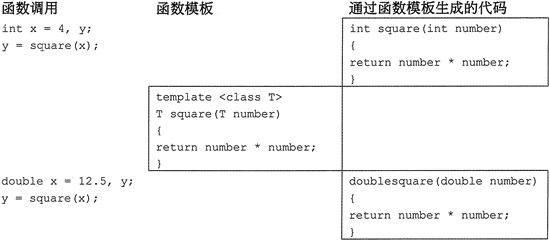int square(int number)
{
return number * number;
}
double square(double number)
{
return number * number;
}
这两个函数之间的唯一区别是它们的返回值及其形参的数据类型。在这种情况下,编写函数模板比重载函数更方便。函数模板允许程序员编写一个单独的函数定义,以处理许多不同的数据类型,而不必为每个使用的数据类型编写单独的函数。
template<class T>
T square(T number)
{
return number * number;
}
函数模板由一个模板前缀标记开始,该模板前缀以关键字 template 开始,接下来是一组尖括号,里面包含一个或多个在模板中使用的通用数据类型。通用数据类型以关键字 dass 开头,后面跟着代表数据类型的形参名称。T square(T number)
其中,T 是类型形参或通用数据类型。该函数头定义了一个 square 函数,它返回一个 T 类型的值,并使用了一个形参 number,这也是 T 类型的数字。
int y, x = 4;
y = square(x);
int square(int number)
{
return number * number;
}
但是,如果使用以下语句调用 square 函数:
double y, d = 6.2;
y = square(d);
double square(double number)
{
return number * number;
}
下面的程序演示了该函数模式的用法:// This program uses a function template. #include <iostream> #include <iomanip> using namespace std; // Template definition for square function template <class T> T square(T number) { return number * number; } int main() { cout << setprecision(5); //Get an integer and compute its square cout << "Enter an integer: "; int iValue; cin >> iValue; // The compiler creates int square(int) at the first occurrence of a call to square with an int argument cout << "The square is " << square(iValue); // Get a double and compute its square cout << "\nEnter a double: "; double dValue; cin >> dValue; // The compiler creates double square(double)at the first // occurrence of a call to square with a double argument cout << "The square is " << square (dValue) << endl; return 0; }程序输出结果:
Enter an integer: 3
The square is 9
Enter a double: 8.3
The square is 68.89

图 1 通过函数模板生成的两个函数实例
本文链接:http://task.lmcjl.com/news/16833.html